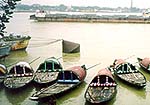


|
|
 |
| HOME | TRAVEL | TRAVELOG | ||

Gently Flows the Hooghly ... life along the ghats in Calcutta Text, Photographs: Tapti Roy The best time to visit any river in India is in the morning. A flurry of typically Indian activities begins at the crack of dawn as the mist rises and the sun falters over overnight clouds, to announce yet another day. Bathing. Worship. Commerce. Ceremonies of birth and death.
The narrow path, lined with trees on one side and separated from the river slope by a concrete railing begins the day unobtrusively. There are the earnest walkers and joggers who come to the river to breathe fresh air as they try to shed the extra ounce. The boatmen huddle under the large trees and bystanders looks on at the river in anticipation of the day ahead.
Settlements emerged and spread, and jostled others as a variety of people came to make this metropolis their home. Its importance lay not only in its transport facilities -- it transported merchandise to the sea and brought men and goods from across the continent -- but also because it was impossible for the Hindu to conduct his rituals, of birth, life and death without the sacred river mediating.
The Strand, constructed by the British just across the road that runs along the western side of Fort William, skirts the river. It was and is an attractive promenade, providing relief from the congestion and clutter of the city growing around it.
Adjoining the Strand, on the north, stands an imposing colonnade with Doric pillars that was erected in the 1840s in honour of James Prinsep, an Indologist who was also secretary of the Asiatic Society. Today it lies forlorn overshadowed by the second bridge over the Hooghly. The impressive structure overlooks a new embankment that was constructed and named after Prinsep. It was from this new ghat that the future British officials boarded their ships to go home. It was a good distance away from the Chandpal ghat, which the white masters had to share with the natives till Prinsep ghat came up.
The first is the Gwalior ghat, a high, flat, round platform jutting out into the river. And ends with a deep drop on to the riverbed. Alongside runs a low wall that leads to a long flight of steps that goes down to the river.
Across the road on top of the steps, fishermen sit sewing large fishing nets, their dark back turned away from the sun. This is also where idols are immersed at the end of every festival. As devotees carefully carry the swaying idols down, a large crowd collects on the two platforms to watch.
Just above the steps stands a large tree with limbs outspread and casting a huge shadow. Beneath the tree is a pit a man is digging. Another man sits at a little distance, vigorously rubbing mud all over his body.
"My name? I am a vagabond. Can I have yours please?" The road runs further north to two jetties and gangways named after the valiant general James Outram. The River Traffic Police now holds sway over the public landing place set up in 1911.
Over the landing berth is a long building with pillars. Babu ghat is a favourite bathing ghat and the place to head for massage. Outside the eroding colonade sits a man selling flowers; inside, in the hall, is an assortment of activities and people. In one corner spread across a wooden bed is a mat. On it lies in passive bliss a rotund man, his eyes closed, revelling in the pleasure of a warm massage. The masseur refuses to have his picture taken. The others are indifferent to the intrusion.
Three men seek salvation and, below the bridge, in front a man prays for the dead; on the bank, some bathe some wander and others prepare to pray. A narrow flight of stairs reaches up to the busy road above. In the small hours of the morning the quiet is deceptive. Very close to Howrah bridge is the Armenian ghat where a flower market is situated. The ghat is a favourite with early morning muscle-builders. Wrestlers and gymnasts flock here for arch-building and bicep-boosting exercises at dawn.
Yet north at Baghbazaar ghat the river is busy. Burdened barges stop off here to unload goods. The Baghbazaar, in a neighbourhood of ancient Bengali mansions, is a hive of activity All these public landing places fall within the purview of the Calcutta Port Trust, which treats them as a minor distraction from more important business. Of course, it receives toll for all the activities conducted on the bank, but takes no responsibility for the cleanliness there. Co-ordination with the city municipality is not the best, as Asim Mukherjee, the officer on special duty, admitted ruefully. And the natural result is that the most venerated area in Calcutta is also the filthiest. The stench rises up into the morning mist, a reminder of the indifference and apathy in high places. And the fact that even the holiest river could do with a clean wash.
|
|
|
Calcutta City Guide
|
|
|
|
|
|
HOME |
NEWS |
BUSINESS |
CRICKET |
MOVIES |
CHAT
INFOTECH | TRAVEL | LIFE/STYLE | FREEDOM | FEEDBACK |
|